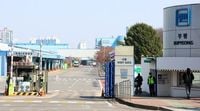GM Korea is facing a precarious future as the clock ticks down to the implementation of U.S. President Donald Trump's 25 percent auto tariffs, set to take effect on April 3, 2025. The company, which relies heavily on exports to the United States, is bracing for significant challenges that could reshape its operations in South Korea.
According to industry reports, GM Korea produced a total of 499,559 vehicles at its plants located in Changwon, South Gyeongsang, and Bupyeong District, Incheon. Alarmingly, 83.8 percent of these vehicles were exported to the United States, highlighting the company's dependence on the American market. In contrast, only 24,800 cars were sold domestically, accounting for a mere 5 percent of its total sales.
The implications of the impending tariffs are dire. The Industrial Bank of Korea has estimated that these tariffs will cut South Korea's annual auto exports by 18 percent, equating to a staggering loss of $6.14 billion. This economic forecast has led to speculation that GM Korea may have no choice but to withdraw from the Korean market if it cannot secure an exemption from the tariffs.
As the news of the tariffs reverberated through the automotive industry, major players like Hyundai Motor and Kia experienced declines in their stock prices, with shares falling by 4.38 percent and 3.45 percent, respectively. Japanese automakers, including Toyota Motor and Nissan Motor, also saw their stock prices plummet in response to the announcement.
In a separate but related development, the recent Supreme Court of Victoria ruling in the case of Beecham Motors Pty Ltd v. General Motors Holden Australia NSC Pty Ltd has sent shockwaves through the Australian automotive retail sector. Although General Motors may view this legal victory as a win, the judgment poses serious repercussions for franchise new car dealers and raises concerns about the balance of power between Original Equipment Manufacturers (OEMs) and their franchised dealers.
Dealers had argued that GM breached an implied obligation to supply Holden vehicles consistently throughout the term of their contracts. However, Justice Lisa Nichols found no such obligation existed, stating that Holden had only committed to “endeavour” to supply vehicles, not guarantee it. This ruling effectively erodes the certainty that franchise dealers have relied upon for years.
Justice Nichols acknowledged that while the availability of cars for retail sale is central to the relationship between OEMs and dealers, the agreement did not confer a general right for dealers to sell Holden-branded cars from their premises. This means that OEMs can reduce, restrict, or cease vehicle supply with limited contractual repercussions.
The implications of this ruling could lead to a shift in the dealer landscape. As OEMs are no longer bound to supply products or maintain brand support, dealers may begin to diversify the brands they represent, embrace parallel import options, or establish multi-branded, independent retail operations that better serve their commercial interests. This decision has the potential to reduce OEM leverage and encourage dealers to reassess their obligations regarding exclusivity and capital investment.
Furthermore, the ruling raises concerns about the loyalty of dealer networks, particularly in regional areas where local businesses play a crucial role in the economy. By undermining mutual obligations, the ruling weakens the franchising model that has long been a cornerstone of the Australian automotive retail industry.
Industry bodies, including the Australian Automotive Dealer Association (AADA) and state-based Motor Trade Associations (MTAs), are advocating for legislative reforms to better protect franchisees. They are calling for clearer minimum supply obligations, enforceable investment protections, and stronger dispute resolution frameworks. Without these reforms, the risk looms that OEMs could dictate terms with little regard for the financial viability of their partners.
In the United States, the impact of the tariffs is already being felt at General Motors and Ford. Leadership at both companies has reassured employees and investors that they are actively working to navigate the challenges posed by the tariffs. GM leadership has communicated to employees that teams are studying the tariff mandate to devise scenarios to mitigate its effects.
Ford CEO Jim Farley has also expressed concerns, stating that the tariffs will likely have a significant impact across the industry. In memos to employees, both automakers emphasized the importance of staying focused on their jobs and being mindful of corporate spending as they adapt to the changing landscape.
Farley warned earlier this year that a 25 percent tariff across the Mexico and Canada borders could “blow a hole in the U.S. industry that we’ve never seen.” Many industry experts predict that the tariffs will lead to substantial cost increases for automakers and suppliers, ultimately raising new vehicle prices by $5,000 to $10,000.
In light of these developments, GM and Ford are working diligently to pinpoint where they are most vulnerable to the tariff impacts. GM imports approximately 46 percent of the vehicles it sells in the U.S., while Ford has a lower import rate of 21 percent, giving it a slight advantage in this tariff environment.
Despite the uncertainty, both companies remain committed to their long-term strategies. GM has reassured employees that it is in a strong position to navigate the dynamic situation and will continue to deliver for customers and communities. Similarly, Ford is dedicated to maintaining quality and cost efficiency as its top operating priorities.
As the automotive industry braces for the repercussions of the tariffs and the fallout from the Australian court ruling, it is clear that the landscape is shifting. Manufacturers and dealers alike will need to adapt to new realities that could redefine the traditional OEM-dealer relationship.






